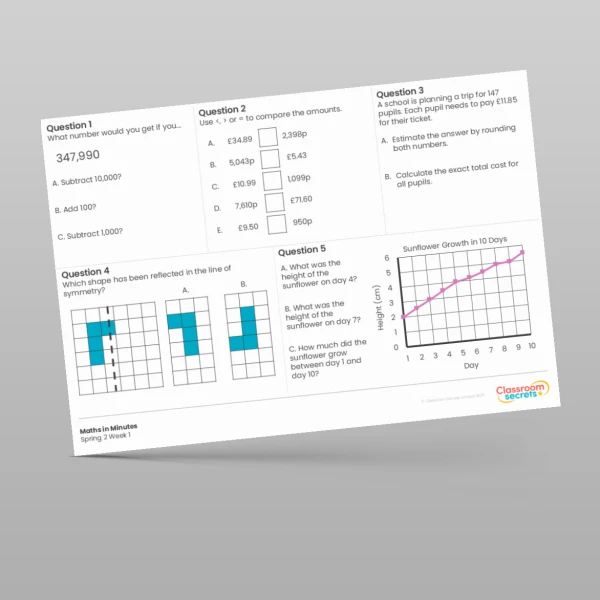

Regular consolidation of previously taught objectives helps to ensure learning sticks! This Year 5 Maths in Minutes resource features three sets of questions covering a range of maths skills including number, geometry, measure and statistics. We've specially designed this resource to be displayed on the interactive whiteboard to save on printing costs and photocopying time. It's perfect to use during registration, at the start of a maths lesson or whenever you have some time to spare. Download today and give it a try!
Curriculum Objectives
- Compare different measures, including money in pounds and pence
- Solve problems involving converting from hours to minutes; minutes to seconds; years to months; weeks to days
- Measure and calculate the perimeter of a rectilinear figure (including squares) in centimetres and metres
- Identify lines of symmetry in 2-D shapes presented in different orientations
- Describe movements between positions as translations of a given unit to the left/right and up/down
- Describe positions on a 2-D grid as coordinates in the first quadrant
- Interpret and present discrete and continuous data using appropriate graphical methods, including bar charts and time graphs
- Solve comparison, sum and difference problems using information presented in bar charts, pictograms, tables and other graphs
- Read, write, order and compare numbers to at least 1,000,000
- Read Roman numerals to 1,000 (M) and recognise years written in Roman numerals
- Interpret negative numbers in context, count forwards and backwards with positive and negative whole numbers, including through zero
- Add and subtract numbers mentally with increasingly large numbers
- Know and use the vocabulary of prime numbers, prime factors and composite (non-prime) numbers
- Multiply numbers up to 4 digits by a one- or two-digit number using a formal written method, including long multiplication for two-digit numbers
- Recognise mixed numbers and improper fractions and convert from one form to the other and write mathematical statements > 1 as a mixed number [for example, 2/5 + 4/5 = 6/5 = 1 1/5 ]
Tags
Spring
4M1
4M4c
4M7a
4G2b
4P2
4P3a
4S1
4S2
5N2
5N3b
5N5
5C1
5C5b
5C7a
5F2a
Maths in Minutes











